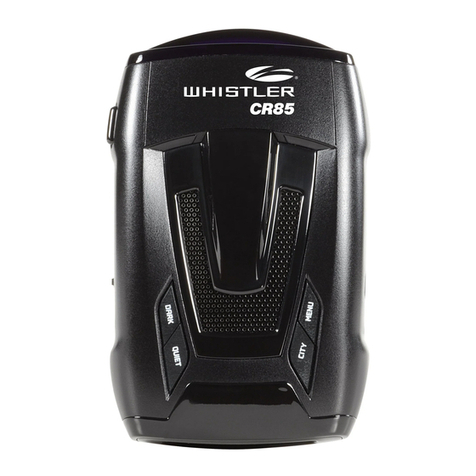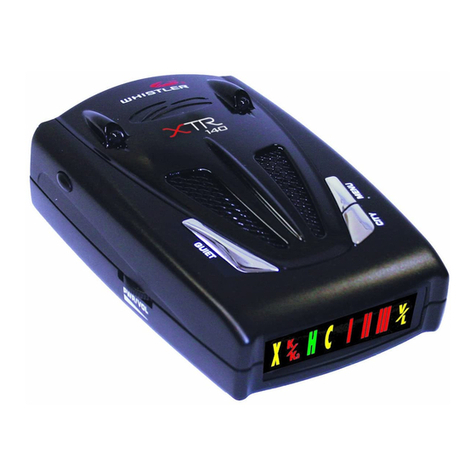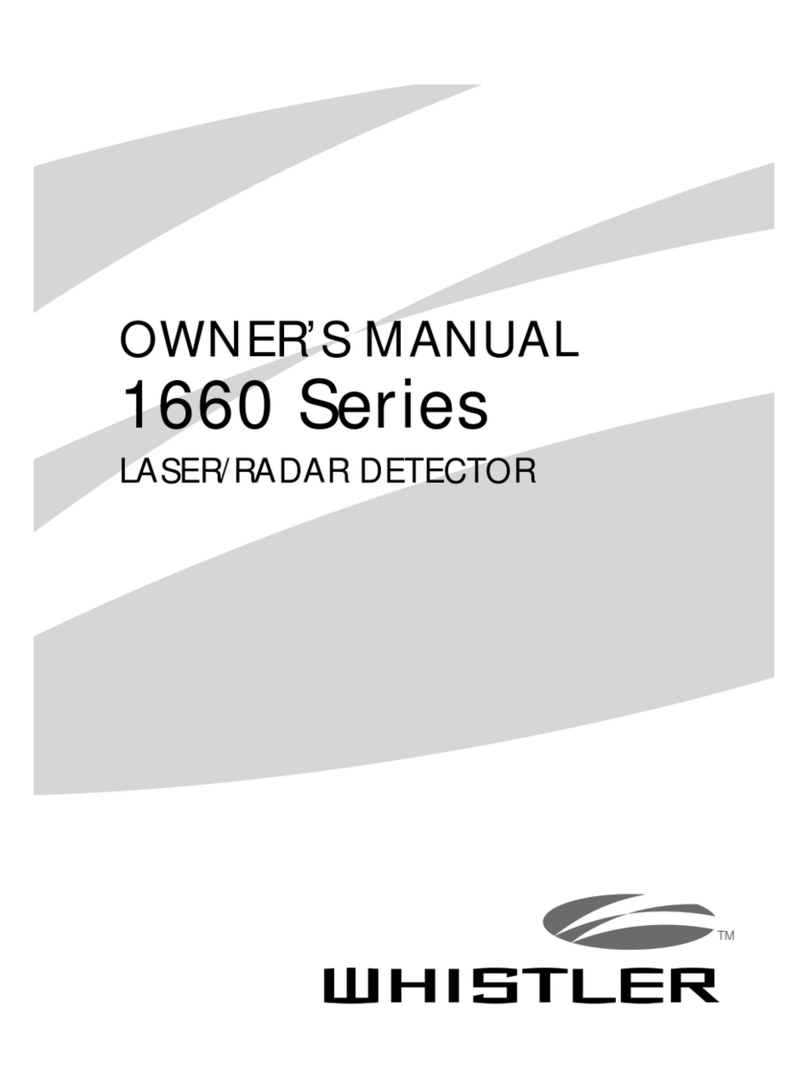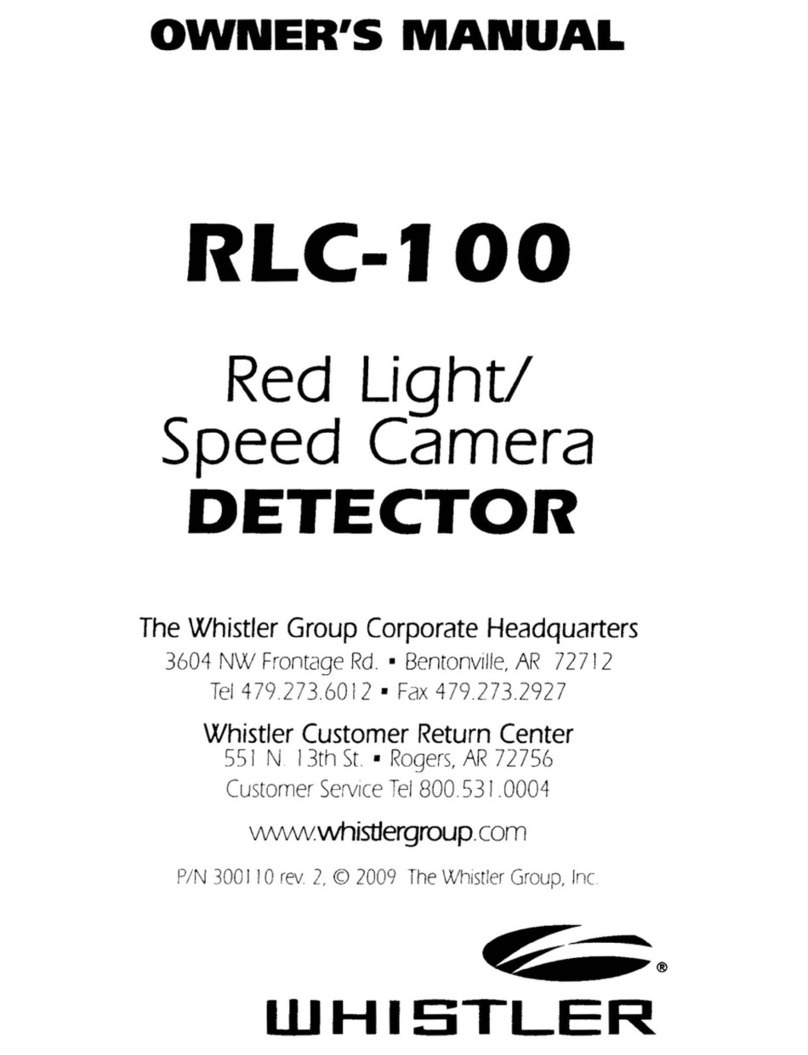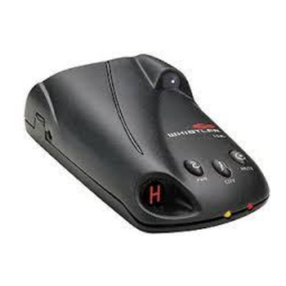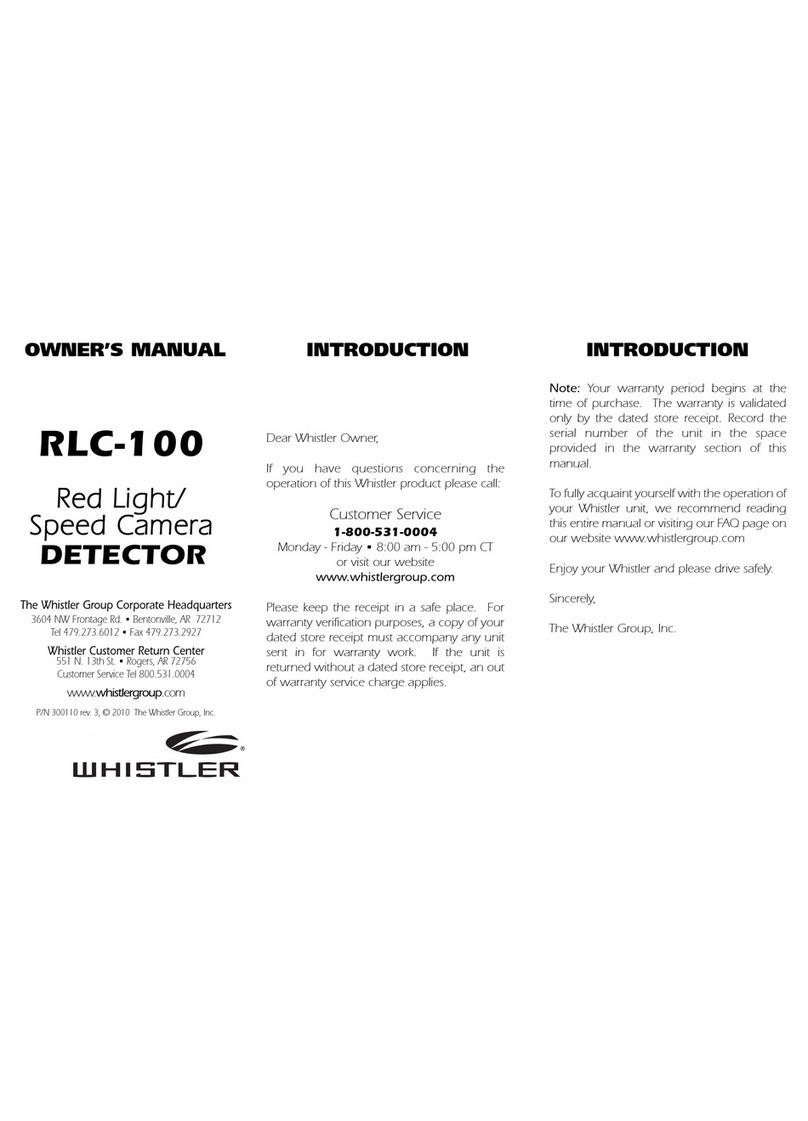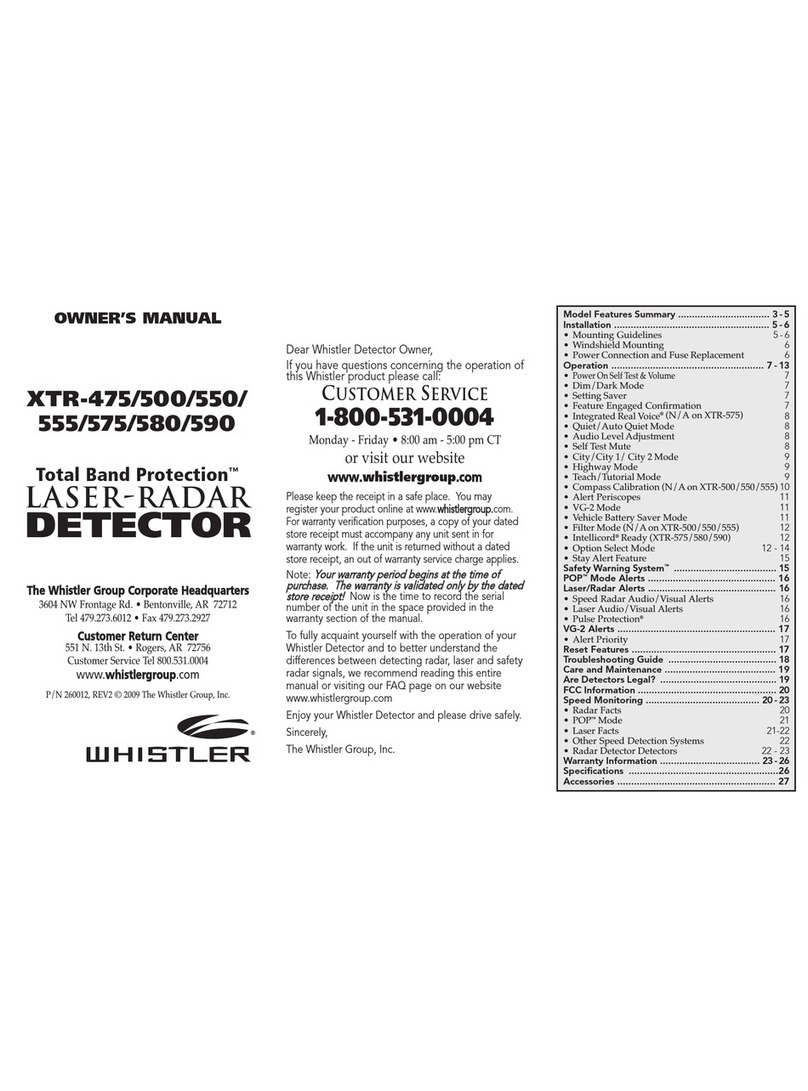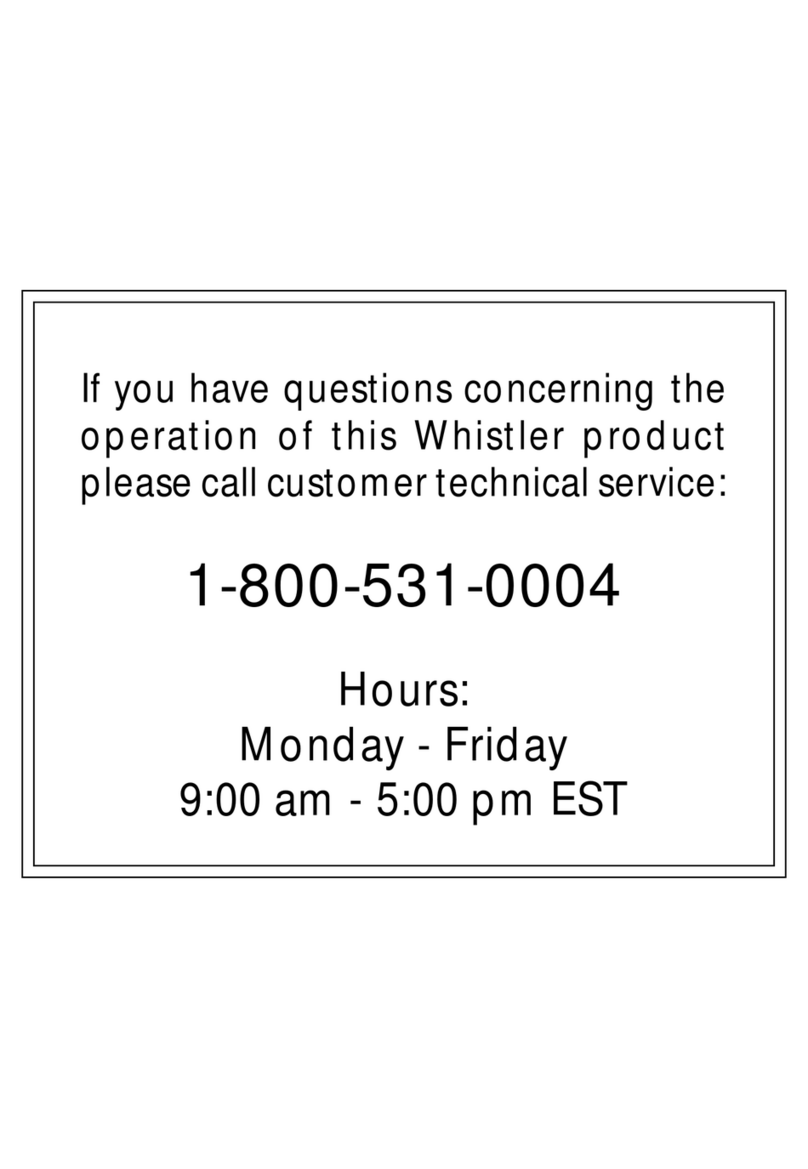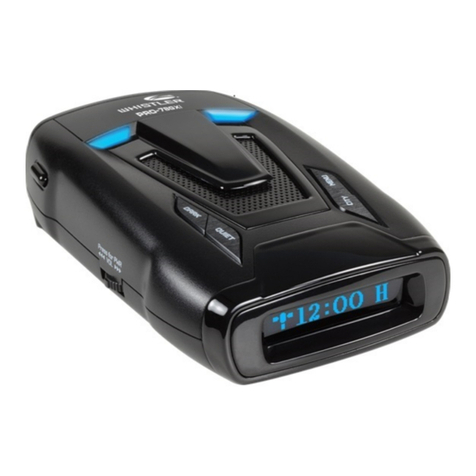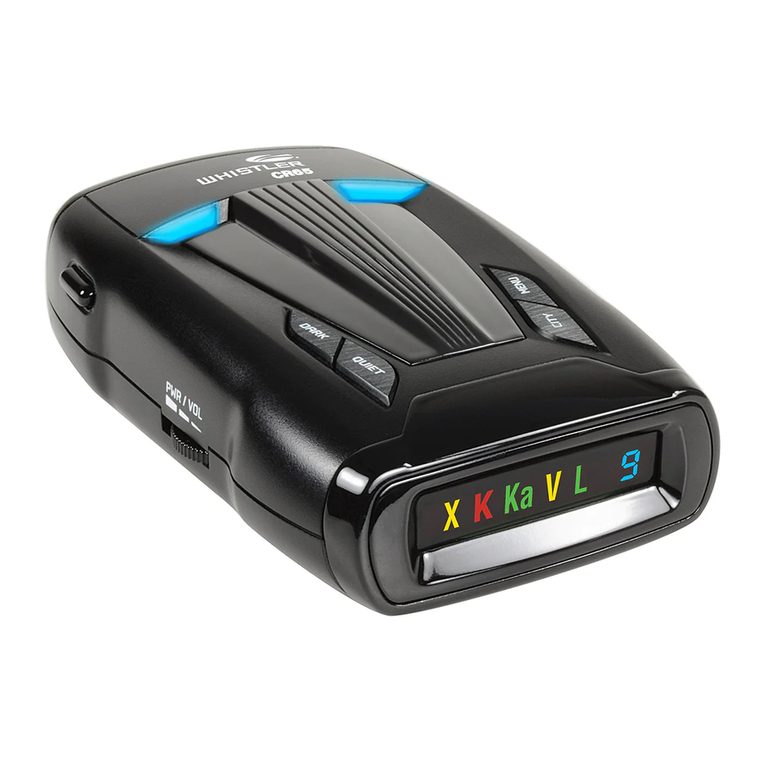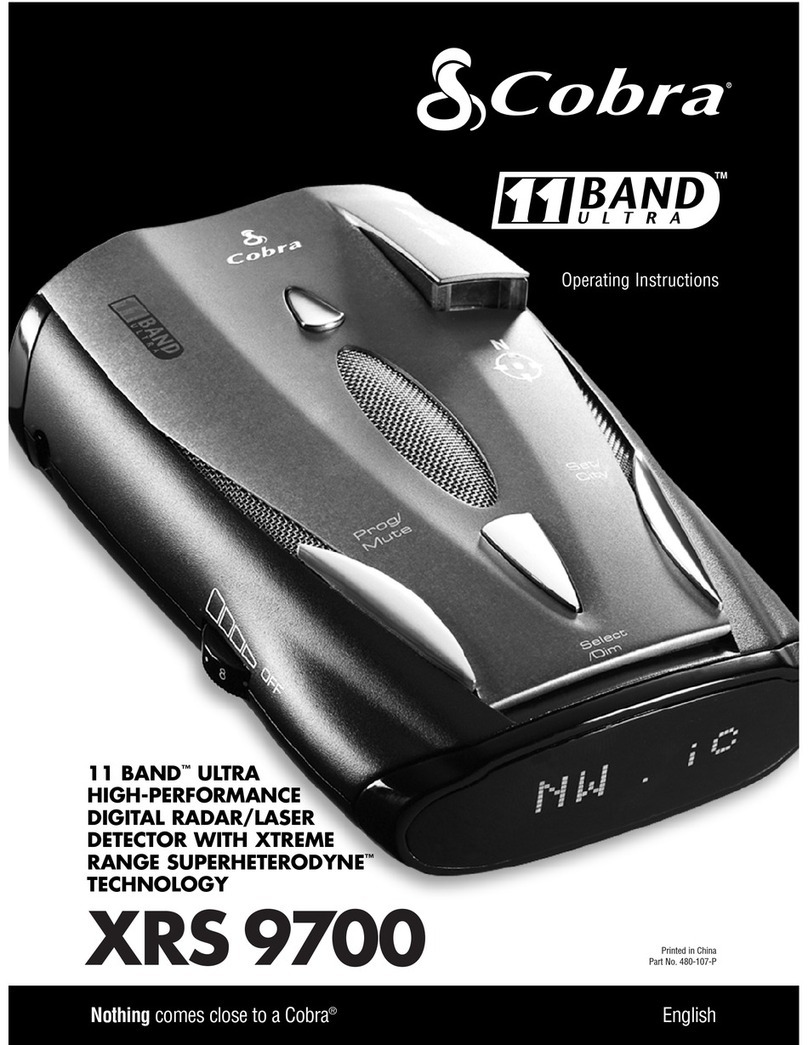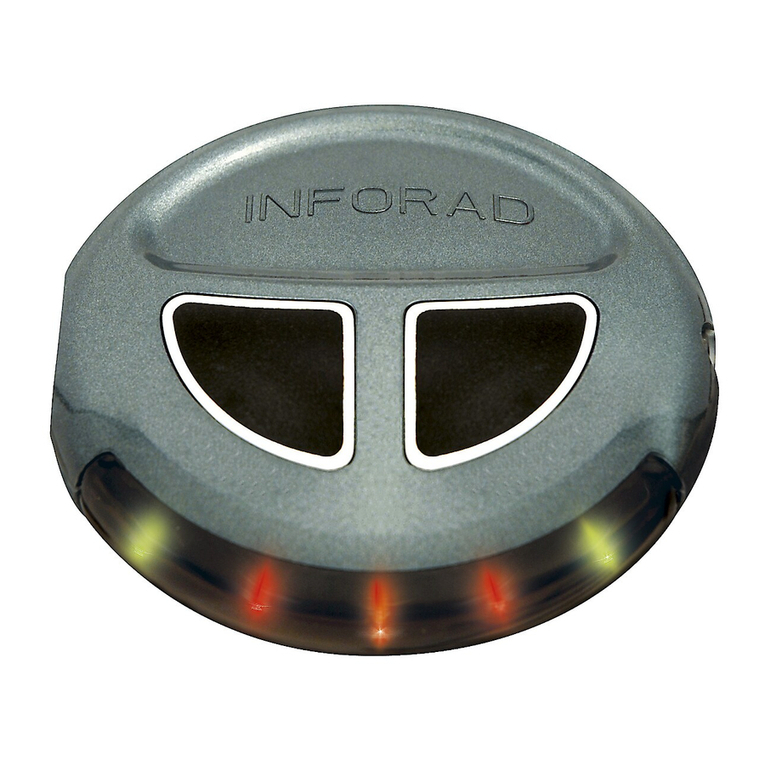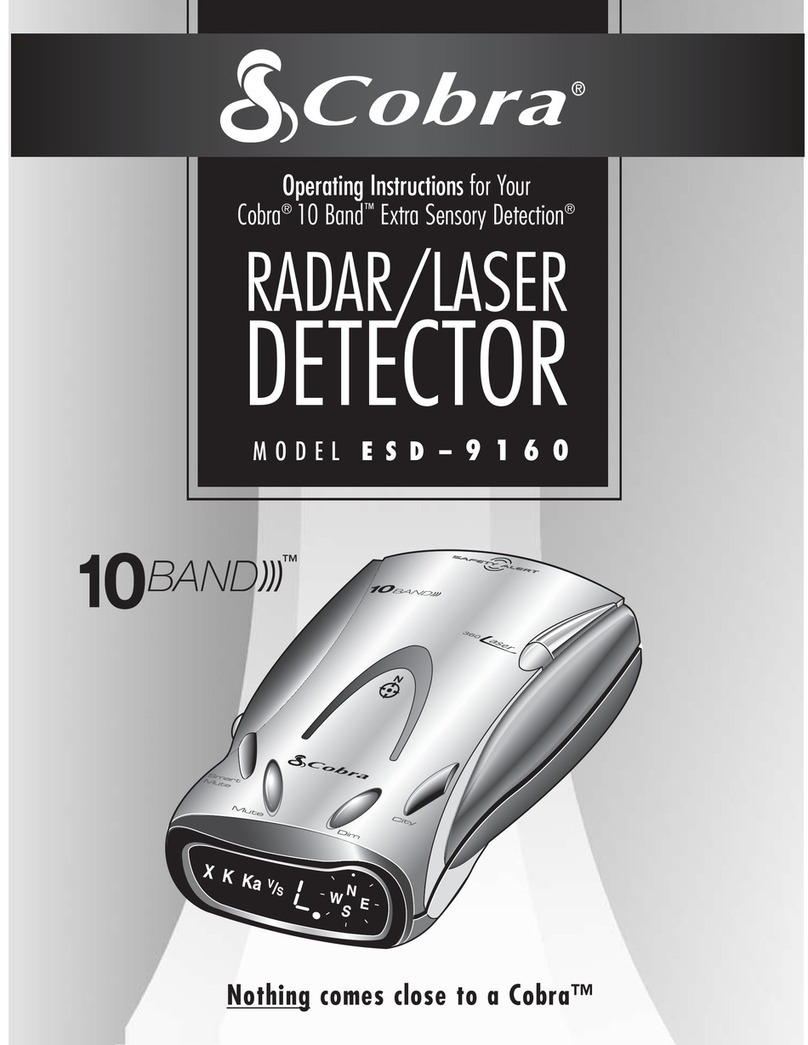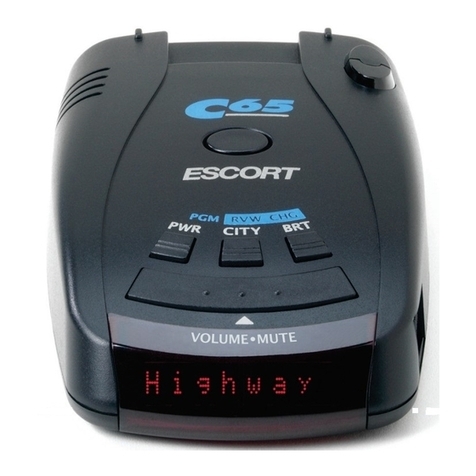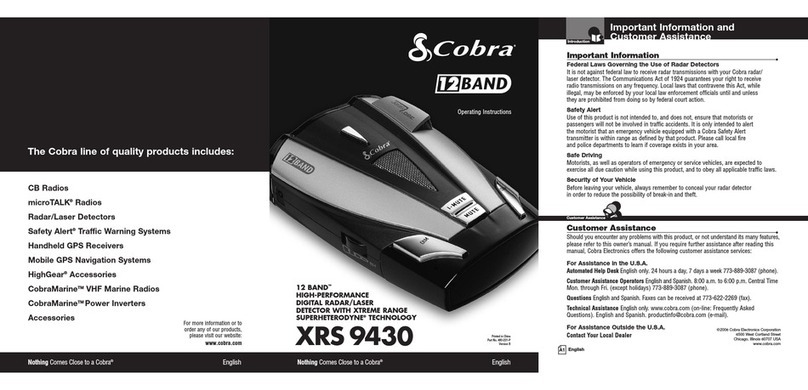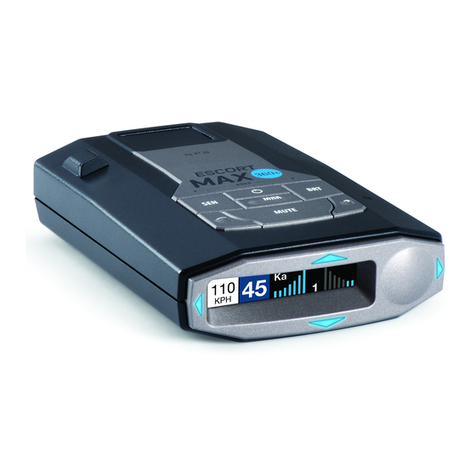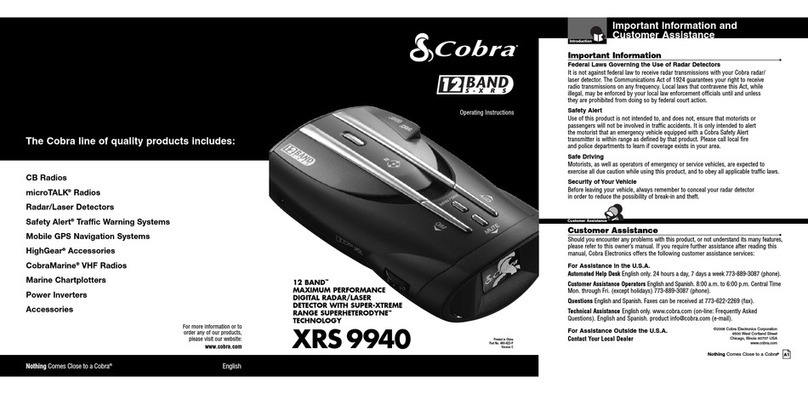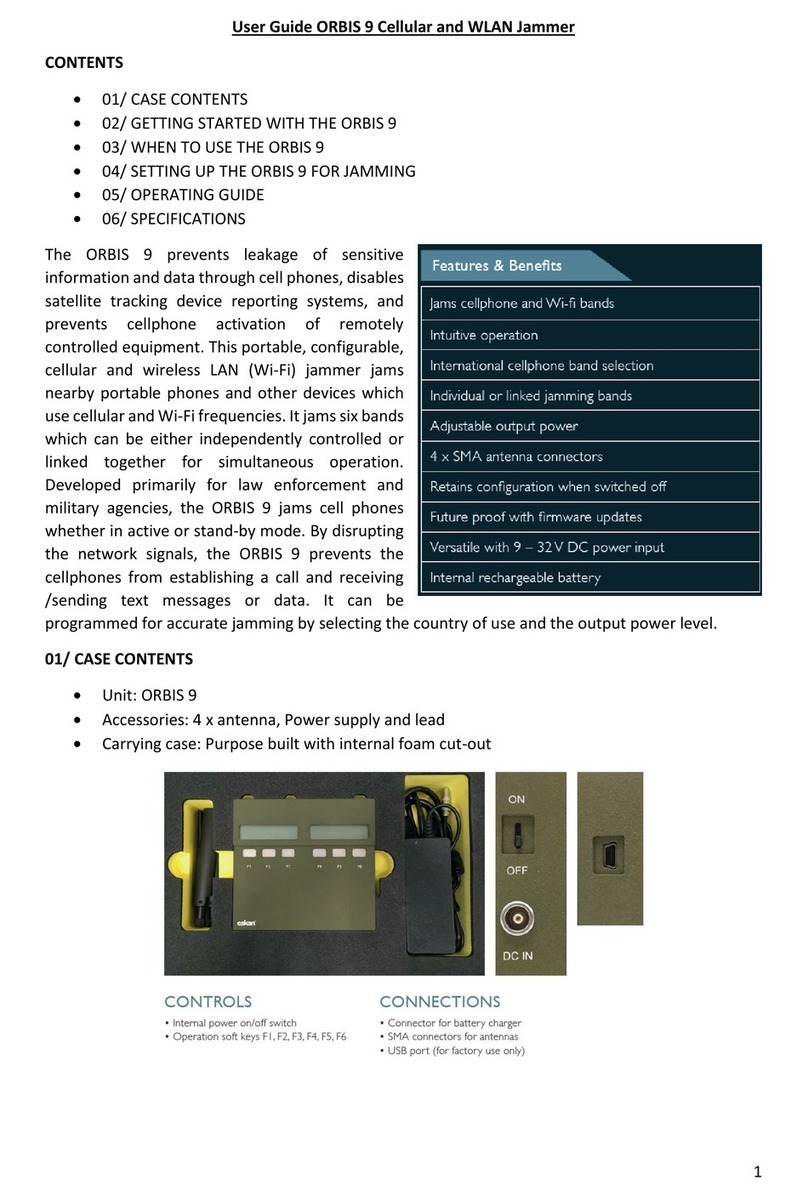X/K and Ka Filter Modes
There are times when a radar detector in
another vehicle, can emit a frequency which can
cause your detector to falsely alert. These Filter
Modes allow you to select the level needed for
your area to minimize the occurrences of these
false alerts.
X/K and Ka Filter Mode factory default settings
should provide adequate filtering for most
conditions. If you experience excessive alerts
due to radar detectors in other vehicles,
increase the Filter level for the band received.
See Option Selection Mode to change the filter
settings.
Traffic Flow Signal Rejection (TFSR)
Recently, many new products operate on X
or K band causing nuisance alerts to radar
detectors. Some of these are radar based Traffic
Monitoring Systems mounted to poles alongside
the highway and others are K Band Lane
Change Assistants and Blind Spot Detectors
found on some automobiles. When turned
on in option mode, helps eliminate excessive
alerts from erroneous X and K-band sources.
Traffic flow monitoring systems are getting more
common. Many of these systems generate radar
signals to measure the flow of traffic across
multiple lanes. Most detectors will alert you to
it unnecessarily. This rejection feature examines
the incoming signal and will aid in reducing the
alerts to such sources.
We suggest you turn TFSR on if you are experiencing excessive
X or K band false alerts every half mile or so along stretches of
roadway that contain these traffic flow sensors.
1. Bracket Release Button – Provides quick
and easy release of the mounting bracket.
2. Speaker – Provides distinct audio warnings
for X, K, Ka band radar, safety warning system
and laser.
3. Mounting Bracket Location – Slot holds
mounting bracket firmly.
4. Radar Antenna – Compact, high-efficiency
antenna receives radar signals.
5. Front Laser Antenna – High gain optical lens
provides increased sensitivity and field of view for
leading-edge laser detection.
6. Rear Laser Antenna – An integrated optical
wave-guide provides superior detection of
laser signals transmitted from behind.
7. City Button - Reduces the annoyance of
false alerts typically encountered in urban
driving areas.
8. Quiet Button - PressingQUIETbeforea
signalisdetectedengagesAutoQuietMode
which automatically reduces the audio level after
the initial warning to a low audio level setting.
PressingQUIETduringaradar/laserencounter
silences audio alerts, while allowing visual
alerts to keep you informed.
9. Power/Volume - Turns unit on/off and
adjusts audio level.
10. Dim/Dark Button - Engages Dim/Dark
mode display options.
11. Menu Button - Enters option select mode.
12. Numeric Icon Display - combines icondisplay with a 7 segment digital display thatshows signal strength indication and band
identification.
13. Alert Periscopes - Provides an
additional attention getting visual alert.
14. X-band Icon - indicates the unit is receiving
a X-band signal.
FEATURE DESCRIPTIONS
15. K-band Icon - indicates the unit is receiving aK-band signal.
16. Ka-band Icon - indicates the unit is receiving
a Ka-band signal.
17. V - indicates that the unit is receiving a VG-2
signal. Indicates that VG-2 is engaged.
18. H - indicates unit is in Highway mode.
19. C - indicates that the unit is operating in city mode.
20. Signal Strength Icon - indicates the strength
of the signal being detected.
21. L - indicates that the unit is receiving a laser signal.
22. Power Jack - provides connection for the power cord
INSTALLATION
Mounting Guidelines
•Mount the unit as low as possible near thecenter of the windshield.
•Do not mount your unit behind wipers,ornaments, mirrored sunscreens, etc. These
obstructions have metal surfaces which canaffect radar and laser signals and reducecritical warning time. (Regular tinted glassdoes not affect reception.)
•Some windshields have an Instaclear™orElectriclear™type coating, which affects radarsignals. Consult your dealer or the vehicle’s
owner’s manual to determine if your windshield
has this coating.
•Avoid placing unit in direct contact with windshield.
•To reduce the possibility of theft, conceal your
unit when not in use.
Windshield Mounting
•Install the two suction cups and rubber bumperonto the bracket by fitting them into their holes.
•Press the suction cups onto the windshield at the
location you have chosen. (Image A)
FEATURE DESCRIPTIONS
Important: Some newer cars have a plastic
safety coating on the inside of the windshield.
The windshield bracket may leave permanent
marks on this type of surface. To find out if your
vehicle has this type of windshield, check the
vehicle’s owner’s manual or ask your dealer.
We recommend that you do not leave the
suction cup bracket on the windshield in direct
sunlight. If the detector is removed, this may
cause blistering of the dash in some vehicles.
• Slide the detector onto the bracket until it
locks into place. (Image B)
• If necessary, the unit may be leveled by
bending the windshield bracket. Press the
bracket release button and remove the
detector before bending.
Power Cord Connection
• Plug the small end of the power cord into the
unit’s power jack.
• Plug the large end into the vehicle’s cigarette
lighter.
Note: Cord fits tightly into detector. When
installing the cord, expect some resistance.
INSTALLATION INSTALLATION
Power On Self Test & Volume
To turn the unit ON or OFF, gently press the center
of the Power/Volume button into the side of the
unit. Each time your Whistler detector is turned on,
an automatic self-test sequence confirms that the
speaker and visual displays are functional.
INTELLICORD®Ready
The optional INTELLICORD®power cable allows
theusertoremotelycontrolPowerandQuiet/Auto
Quietfunctionswiththepressofabuttonlocated
on the power cable’s plug.
Setting Saver
Setting Saver stores your personalized settings so
that when the detector is turned off and then on
again, you do not have to re-enter them.
Feature Engaged Confirmation
Each time a button is pressed one beep confirms
feature “on”, two beeps confirm feature “off”
Audio Level Adjustment
The audio levels can be adjusted high to low or
low to high.
• Rotate Power/Volume button back to increase
audio level.
• Rotate Power/Volume button forward to
decrease audio level.
As audio level is adjusted, beeps are provided
and the display indicates volume level.
OPERATION OPERATION
Alert Periscopes
Whistler’s Alert Periscopes provide an added
attention getting visual alert. The two extra LED’s
flash on and off when the unit alarms to provide a
unique visual alert. This alert can be programmed
through the Option Select Mode to be: ON, OFF,
or FLASHING during alerts.
City/City 1/City 2 Modes
Whistler’s Three Stage City Mode is designed
to reduce the annoyance of automatic door
openers, intrusion alarms and other devices
which share frequencies with police radar.
Generally, X band is used for these devices.
•PressCitytocancelHighwayModeand
engage City Mode.
•PressCitybuttonagaintoenterCity1Mode
•PressCitybuttonagaintoenterCity2Mode
•PressCityafourthtimetocancelCity2Mode
and return the unit to Highway Mode.
In City Mode, weak speed/safety warning
system signals give an initial alarm of two
beeps, and then remains quiet unless the signal
becomes very strong. When the signal strength
increases, two additional beeps are provided.
City 1 and City 2 Modes operate the same as
Highway Mode, but in City 1 Mode, X band
requires a stronger signal to alert. In City 2
Mode, X-band is not detected.
Caution: Some towns/small cities may still be
using X band radar. City Modes do not change
the audio alert for laser.
OPERATION
Highway Mode
Highway mode provides full audio warnings any
time radar (X, K, Ka, Safety Warning System) or
laser signals are detected, and is recommended
for open road driving.
Teach/Tutorial Mode
Provides simulated alerts for each type of signal.
•PressCityandQuietbuttonssimultaneously
and release.
•PressPowertoexit.
Dim/Dark Modes
Dim/Dark Mode reduces the illumination of the
display
•PressandreleasetheDarkbuttontoreduce
illumination to a dim setting.
•PressandreleasetheDarkbuttonasecond
time to engage Dark Mode. The display
illumination is further reduced.
Dim or Dark can be engaged during an alert. In
Dark Mode, the display goes dark for as long as
a signal is being detected and 20 seconds after,
then the display returns to the dimmer setting.
•PressandreleasetheDarkbuttonathirdtime
to restore the display to full illumination.
OPERATION
Vehicle Battery Saver Mode
The Vehicle Battery Saver Mode automatically
shuts off your detector within 6 hours. The timer
is reset if the detector is turned off, unplugged
or any button is pressed before the timer has
expired. The detector will alert you with an
audible and visual warning before it shuts off.
During this warning you can reset the timer by
pressing any button.
If the unit has automatically turned itself off,
press the Power button to turn the unit back on.
You can manually engage the Vehicle Battery
Saver Mode by pressing and holding the City
button until one beep is heard.
Integrated Real Voice®
When selected, Real Voice®will be used to
articulate the following:
1. Band Identification
2. Safety Warning System messages
3. Feature Selection
Note: In certain cases, the voice message does
not replicate the text message.
Voice OFF/ON is selected by holding quiet
button for approximately 2 seconds. Voice ON
will announce “caution”, Voice OFF will give a
double beep.
OPERATION OPERATION
Option Select Mode
Press the Menu button to enter Option Select Mode.
Each press of the Menu button changes to the next
selectable feature.
TheDark(D)buttonandtheQuiet(Q)buttonturns
the feature ON/OFF or Blinking. The decimal point
illumination indicates whether a feature is on or off. A
button must be pressed within 20 seconds or Option
Select Mode will automatically be exited.
Self Test Mute
PresstheQuietbuttonduringtheSelf-Test
sequence to cancel the Self-Test audio. This will
not affect radar/laser alerts. To restore the Self-
Testaudio,presstheQuietbuttonduringthenext
Self-Test.
Quiet Mode
Quietcancelsaudioduringanalertandanynew
alert within 20 seconds. After 20 seconds of no
alerts, the audio is restored for any new alerts.
• PressQuiettocanceltheaudio.
• PressQuietasecondtimeduringanalertto
restore the standard audio alert pattern; or
turn the unit off, then on.
Auto Quiet Mode
AutoQuietreducestheselectedaudiolevelto
level (1) approximately 5 seconds after a radar
or safety warning system signal is detected. The
alert for any new signal within 20 seconds will
resumeatlevel(1).AutoQuietdoesnotaffect
laser alerts.
• PressQuietbutton(beforeasignalis
detected)toengageAutoQuiet.
• OncetheAutoQuietmodeisengaged,you
may cancel the audio alarm by pressing
Quiet.
• PressQuiet(whentheunitisnotalarming)to
cancelAutoQuietmode.
OPERATION
WHISTLER FEATURES
Rubber Bumper
Windshield
Mounting
Fuse Replacement
The lighter socket plug is equipped with a
replaceable 2 amp, 3AG fuse located behind
the silver tip. To replace the fuse, carefully
unscrew the tip of the plug.
Important:Unscrewslowly.Thetipcontainsa
spring which may fly out when disassembling.
Insert the new fuse with the spring and screw
on the tip. With use, screw cap on plug may
loosen. Retighten occasionally.
Installing the Hardwire Kit
The“U”typeconnectormustbesecuredtoa
metal surface that is electrically connected to
the battery ground (negative) terminal.
The spade type connector can connect to either
live 12 volts or switched 12 volts at your fuse
panel accessory port.
If no port is available, cut off the spade
terminal, expose 1/4 to 1/2 inch of wire, and
splice into a source of 12 volt power.
Fuse Replacement - Hardwire Kit
The inline fuse holder on the power cable is
equipped with a replaceable 2 amp, 3AG fuse
located inside the fuse holder.
To replace the fuse, carefully twist the holder to
open it to gain access to the fuse.
Feature Display To Change Option
Laser
(default = ON) L. D for ON
Q for OFF L. = ON
L = OFF
Alert Periscopes
(default=Blinking
with alert)
.D or Q
to select ON, OFF
BLINKING
X Band
(default = ON) X. D for ON
Q for OFF X. = ON
X = OFF
K Band
(default = ON) K. D for ON
Q for OFF K. = ON
K = OFF
Ka Band
(default = ON) Ka. D for ON
Q for OFF Ka. = ON
Ka = OFF
POP Mode
(default = OFF) PD for ON
Q for OFF P. = ON
P = OFF
SWS
(default = OFF) SD for ON
Q for OFF S. = ON
S = OFF
TFSR
(default = OFF) tD for ON
Q for OFF t. = ON
t = OFF
X/K
Filter X K F 1 D or Q
to select
F1 = Filter (Default)
F2 = Filter 2
F3 = Filter 3
Ka
Filter Ka F 1 D or Q
to select
F1 = Filter (Default)
F2 = Filter 2
F3 = Filter 3
NOTE: Press the Power button to exit Option Select
Mode.
45
3
•HighPerformance
•3FilterModes
•SelectableTones
•TotalBandProtection™
•NumericIconDisplay
•DetectsPOP™ Mode
•360°MaxxCoverage
•RealVoice®
•3CityModes/HigwayMode
•LowEmission
•Quiet/AutoQuietMode
•Dim/DarkMode
•StayAlert™
•SettingSaver
•VehicleBatterySaver™
•Safety Warning System™
•AlertPriority
•AlertPeriscopes
•TrafficFlowSignalRejection
•HighGainLens
Features
2
9
6
1
8
10 11
7
13
12
22
17
21
14
15
18,19,
20
16
OWNER’S MANUAL
CR80
HIGH Performance
LASER-RADAR
DETECTOR


